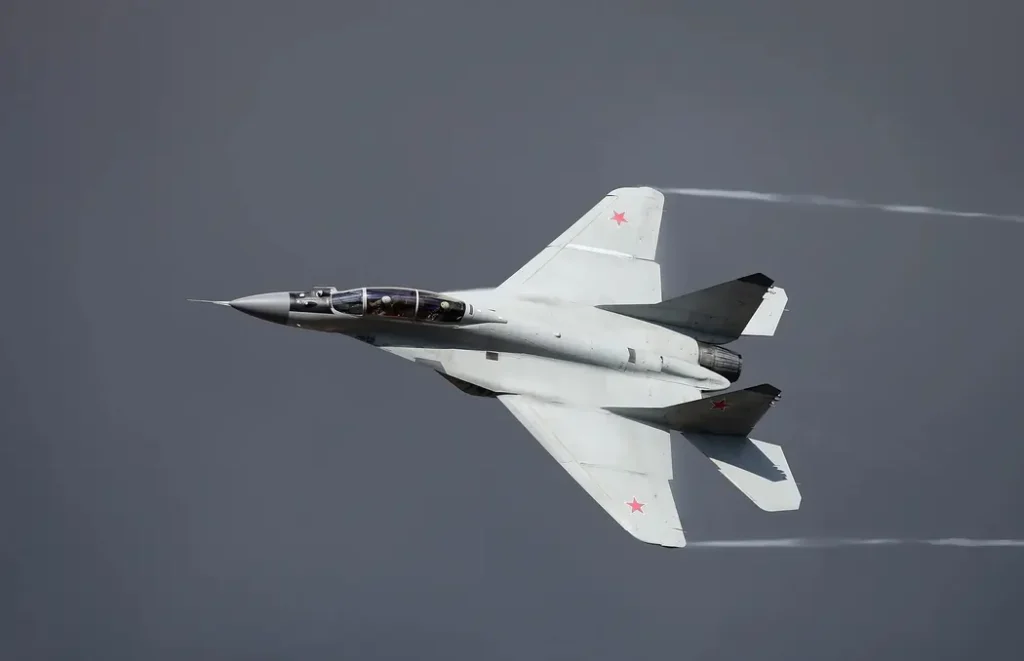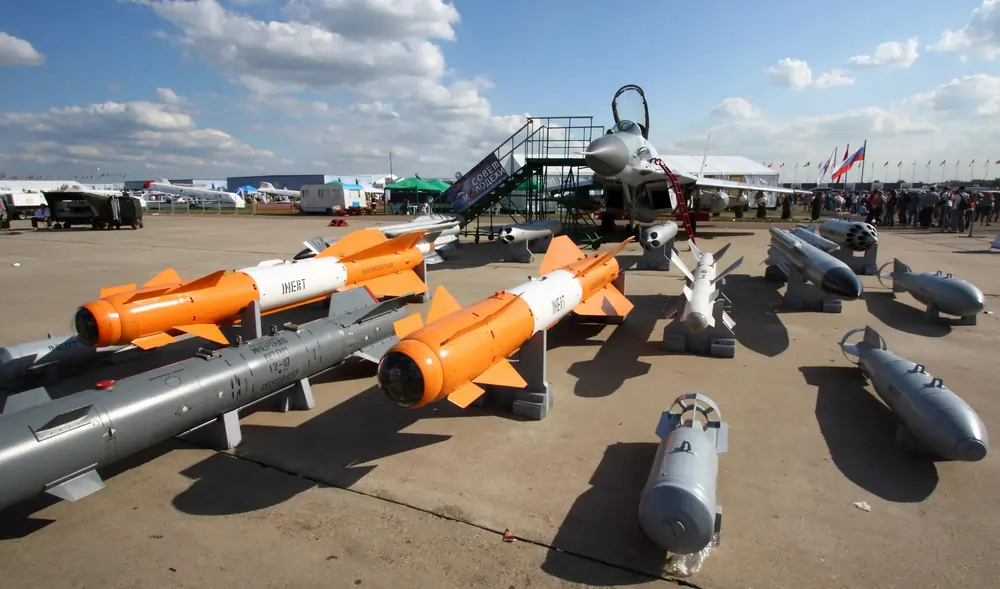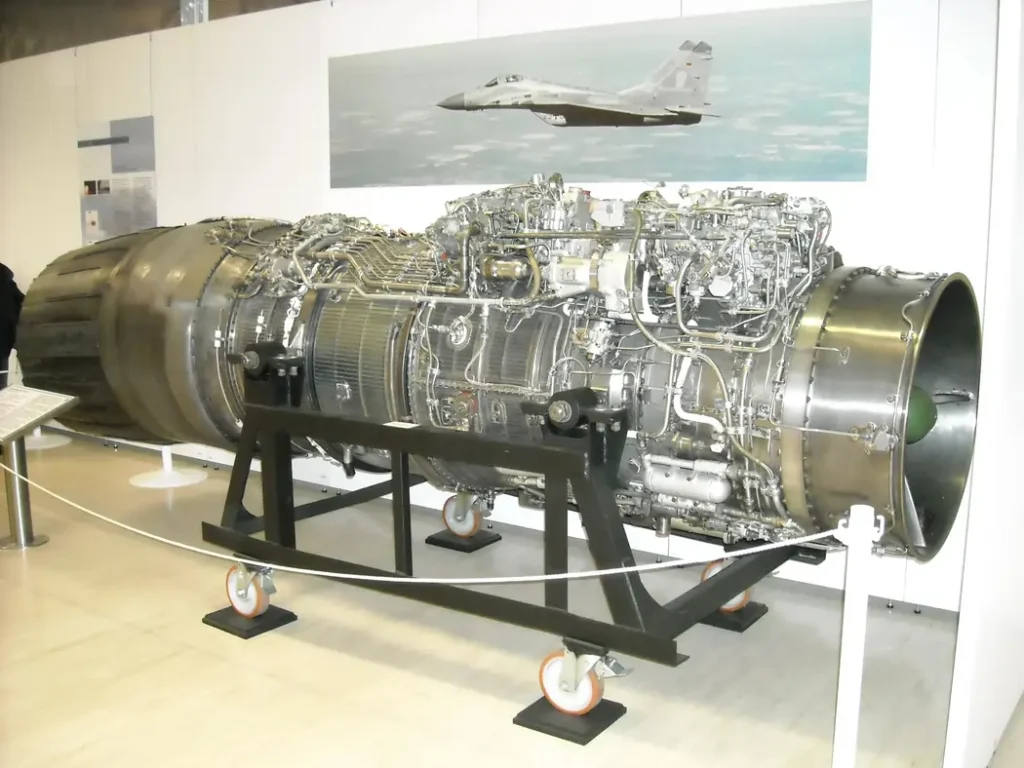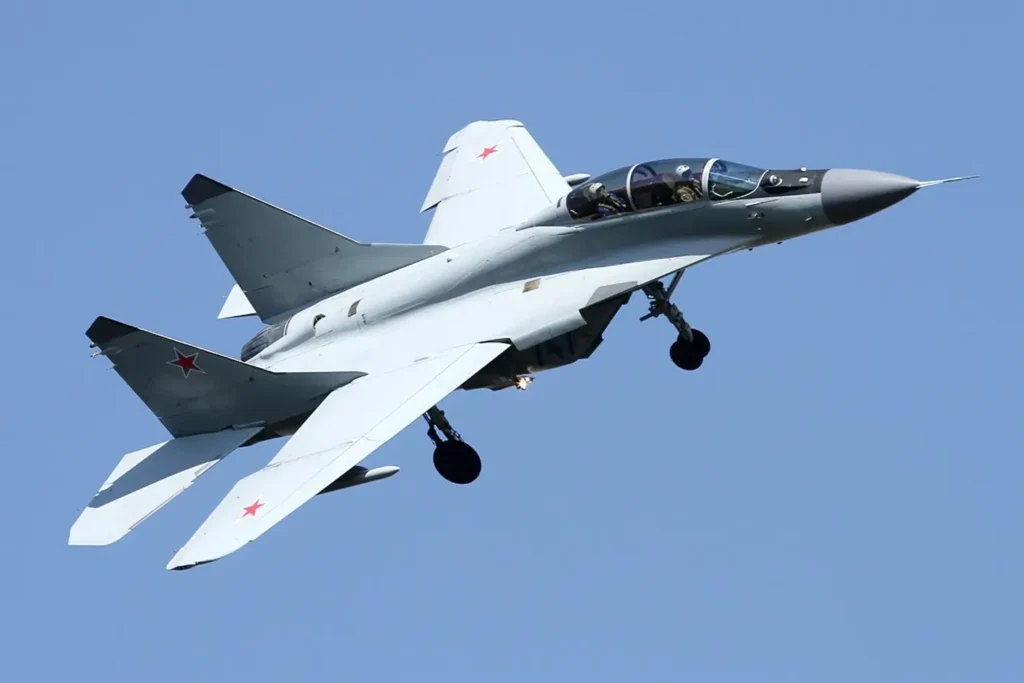In the world of military aviation, few aircraft have garnered as much attention and admiration as the MiG-29 Fulcrum. Developed by RSK MiG and the Irkutsk Aircraft Production Association Joint Stock Company, this versatile fighter bomber has earned its stripes across the globe. Known by its NATO codename “Fulcrum”, the MiG-29 has evolved over the years, adapting to changing combat requirements and technological advancements. Let’s delve into this iconic aircraft’s rich history, capabilities, deployments, and upgrades.
Table of Contents
Mig-29M Specifications
| Parameter: | Description: |
|---|---|
| Manufacturer | RSK MiG and Irkutsk Aircraft Production Association Joint Stock Company |
| Model | MiG-29M |
| NATO Code Name | Fulcrum |
| Variant | Carrier-based version |
| Maiden Flight | October 1977 |
| Entered Service | August 1983 |
| Mission | Destroy hostile air targets within radar coverage limits and ground targets using unguided weapons in visual flight conditions |
| Profile | Fixed-wing profile with large-wing leading-edge root extensions |
| Maneuverability | Good maneuverability and control at subsonic speeds, including high angles of attack; maximum operational g-loading: 9g |
| Seating | Two-seater (MiG-29M2 variant) |
| Thrust-Vectoring Engine Nozzles | Demonstrated at Farnborough International Airshow in July 2006; 3D thrust-vectoring engine nozzles with three hydraulic actuators |
| Offered as | MiG-35 |
| Operational Status | Deployed worldwide; approximately 1,600 operational globally; about 600 in service with Russian Air Force |
| Orders and Deliveries | Various orders and deliveries worldwide; notable orders from India, Sudan, Algeria, Mongolia, and others |
| Upgrade Programs | Ongoing upgrade programs by various countries and entities for enhanced performance and modernization |
| Engines | Dual RD-33 turbofan engines |
| Air Intakes | Dual-mode air intakes; open during flight, closed on ground to prevent foreign object ingestion |
| Maximum Speed | 2,400 km/h (altitude), 1,500 km/h (near the ground) |
| Service Ceiling | 18,000 meters |
| Range | 1,430 km (altitude), 700 km (near the ground) |
| Maximum Take-off Weight | 18,000 kg |
| Maximum Operational G-loading | 9g |
| Weapon Hardpoints | Seven external hardpoints for various weapon configurations |
| Weaponry | Can carry air-to-air missiles, unguided rockets, air bombs, and a built-in 30mm aircraft gun |
| Targeting Systems | Includes radar system, infrared search and track sensor, laser rangefinder, helmet-mounted target designator |
| Upgraded Systems | Modernized avionics, glass cockpit, digital fly-by-wire control systems, improved radars, and more |
| Contracts & Agreements | Various contracts for upgrades, maintenance, and procurement with different countries and entities |
| Performance | Climbing rate: 330m/s; ferry range: 2,100 km; maximum speed: 2,400 km/h; cruise speed: 1,500 km/h |
| Weight | Approximately 11,000 kg |
Evolution and Features of MiG-29
The MiG-29 traces its roots back to the late 1970s when it first took to the skies in October 1977. Designed for air superiority and ground attack missions, the MiG-29 boasts a fixed-wing profile with large wing leading-edge root extensions, providing exceptional maneuverability and control at subsonic speeds. Its maximum operational g-loading of 9g ensures agility in combat scenarios.

Over the years, the MiG-29 family has expanded to include variants such as the carrier-based MiG-29K and the two-seater MiG-29M2. The MiG-35, a super-maneuverable variant equipped with 3D thrust-vectoring engine nozzles, is notable among these, demonstrated at the Farnborough International Airshow in July 2006.
Global Deployments
With approximately 1,600 operational worldwide, the MiG-29 has found homes in the air forces of numerous nations. From Russia to India, Algeria to Yemen, this aircraft has served across diverse theaters of operation. Its mission versatility, coupled with robust performance characteristics, has made it a favored choice for air forces spanning continents.
Orders, Deliveries, and Upgrades
The MiG-29’s journey is marked by a slew of orders, deliveries, and upgrade programs, reflecting its enduring relevance in modern warfare. From India’s acquisition of MiG-29Ks for its indigenous aircraft carrier to Algeria’s procurement of 34 fighters, the aircraft continues to attract interest globally.
Upgrade programs, such as Russia’s MiG-29SMT initiative, aim to enhance the aircraft’s capabilities through improved avionics, radar systems, and in-flight refueling probes. Collaborations with companies like EADS and Thales have further propelled the MiG-29 into the realm of cutting-edge technology, ensuring its longevity on the battlefield.
Weapons and Targeting Systems
Armed to the teeth, the MiG-29 boasts an array of weapons systems tailored for diverse combat scenarios. From air-to-air missiles like the R-27 and R-73 to unguided rockets and air bombs, the aircraft can unleash devastation upon its adversaries. Advanced targeting systems, including radar and infrared sensors, ensure precise engagement of hostile targets.

Engines and Performance
Powered by two RD-33 turbofan engines, the MiG-29 achieves impressive performance metrics. With a maximum speed of 2,400km/h and a service ceiling of 18,000m, it stands as a formidable presence in the skies. Dual-mode air intakes allow for efficient operation both in flight and on the ground, enhancing reliability and safety.

Conclusion
The MiG-29 Fulcrum stands as a testament to the ingenuity and innovation of its designers. From its maiden flight in the late 1970s to its continued service in the 21st century, this aircraft has proven its mettle time and again. As it evolves to meet the challenges of modern warfare, the MiG-29 remains a symbol of excellence in aerial combat.
Read More Articles
- Why Cyber Security is Essential: Exploring 5 Key Reasons
- Astra Space’s Financial Struggles: A Close Brush with Bankruptcy
- Introducing the Xogdor Rocket to the Military Realm
- The Formation of the LEO Owner Operators Affinity Group
- Expanding Satellite-to-Smartphone Connectivity
- Navigating Privacy and Safety in Adult Webcam Streaming
- Choosing Between Open Source and Proprietary LLMs
- Rethinking Food Packaging for a Sustainable Future
- Mastering Typography in Web Design
- Exploring Typography Trends for Digital Design in 2024
- Unlocking Sustainable Economic Growth Through Innovation
- Navigating the Financial Landscape of Executive Education and MBA Programs
- Understanding Information Technology: The Backbone of Modern Business
- Understanding Algorithms: Definition, Functionality, and Real-Life Applications
- Understanding Machine Learning: A Comprehensive Exploration
- Unlocking the Power of Machine Vision: Revolutionizing Industries
- Unlocking the Power of Expert Systems: Enhancing Decision-Making with AI
- Unlocking the Power of Natural Language Processing
- Unlocking the Secrets of Artificial Intelligence
- Optimizing Logistics with AI: Revolutionizing Efficiency in Package Routing
Frequently Asks Questions
What is the MiG-29 Fulcrum?
The MiG-29 Fulcrum is a fourth-generation, twin-engine air superiority fighter aircraft developed by the Soviet Union’s Mikoyan Design Bureau in the 1970s. It was designed to counter Western aircraft like the F-15 Eagle and the F-16 Fighting Falcon.
What are some key features of the MiG-29?
The MiG-29 is known for its agility, powerful engines, and advanced avionics. It features a delta wing and canard design, giving it excellent maneuverability at both high and low speeds. Its radar and weapons systems allow it to engage multiple targets simultaneously.
What role does the MiG-29 serve in modern air forces?
The MiG-29 serves as a multirole fighter in many air forces around the world. It can perform air superiority missions, ground attacks, and reconnaissance roles. It has seen combat in various conflicts, including the Gulf War, the Yugoslav Wars, and the Syrian Civil War.
How does the MiG-29 compare to other fighter aircraft?
The MiG-29 is often compared to Western counterparts like the F-16 and the F/A-18. While it may not have the same level of avionics or range, it excels in terms of maneuverability and climb rate. Its high thrust-to-weight ratio gives it impressive acceleration and vertical performance.
What are some notable variants of the MiG-29?
Over the years, several variants of the MiG-29 have been developed, including the MiG-29A, MiG-29S, MiG-29K, and MiG-29M/M2. Each variant offers improvements in avionics, weapons systems, and performance tailored to specific operational requirements.
What are some of the challenges associated with operating the MiG-29?
Like any complex military aircraft, the MiG-29 requires skilled maintenance and support personnel. Its advanced avionics and systems demand regular maintenance to ensure reliability and safety. Additionally, operating older variants may pose logistical challenges due to spare parts availability.
How effective is the MiG-29 in modern aerial combat scenarios?
The effectiveness of the MiG-29 depends on various factors, including pilot training, mission planning, and the capabilities of opposing forces. While it may not be as technologically advanced as some Western fighters, its agility and weapons systems still make it a potent adversary in the right hands.
What are some recent upgrades and modernizations to the MiG-29?
Many operators of the MiG-29 have pursued upgrade programs to enhance the capabilities of their fleets. These upgrades often include improved avionics, radar systems, and compatibility with modern weapons. Some upgrades also focus on extending the aircraft’s service life and reducing maintenance costs.
How does the MiG-29 contribute to national defense strategies?
The MiG-29 plays a crucial role in safeguarding airspace and supporting ground forces in various countries. Its ability to perform a wide range of missions, from air defense to ground attack, makes it a versatile asset in national defense strategies.
What does the future hold for the MiG-29?
Despite being an older design, the MiG-29 continues to be relevant in modern air combat operations. Many operators are investing in upgrades and modernizations to keep their fleets capable and effective. Additionally, the development of next-generation fighters may lead to further advancements and upgrades for the MiG-29 platform, ensuring its continued relevance for years to come.


